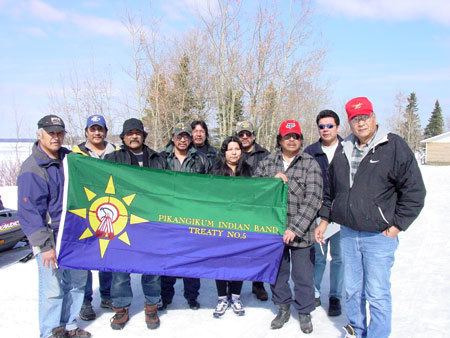First Nation Pikangikum Elevation 335 m Population 2,100 (2006) Area code 807 | Time zone CST (UTC-6) Area 1,808 km² | |
 | ||
The Pikangikum First Nation (/pɪˈkændʒɪkəm/, Ojibwe: pointed: ᐱᑳᐣᒋᑲᒦᐣᐠ ᐯᒫᑎᓯᐚᐨ; unpointed: ᐱᑲᒋᑲᒥᑭ ᐯᒪᑎᓯᐘᒋ; Bigaanjigamiing Bemaadiziwaaj; locally: Beekahncheekahmeeng Paymahteeseewahch) is an Ojibwe First Nation located on the 1,808-hectare (4,470-acre) Pikangikum 14 Reserve, in Unorganized Kenora District in Northwestern Ontario, Canada. The main centre is the community of Pikangikum, on Pikangikum Lake on the Berens River, part of the Hudson Bay drainage system; it is approximately 100 kilometres (60 mi) north of the town of Red Lake.
Contents
- Map of Pikangikum ON Canada
- Society
- Clans
- Government
- Transportation
- Economy
- Whitefeather Forest Initiative
- Recreation
- Youth suicide
- References
Map of Pikangikum, ON, Canada
The community has a registered population as of September 2011 of 2,443, of whom 2,334 live on the reserve.
Society
A 2005 Wawatay Native Communications Society survey found that the residents of Pikangikum have one of the highest rates of original language retention of any First Nation in Northern Ontario. The language is Ojibwemowin, the major dialect of Anishinaabe peoples (see Berens River Ojibwe language). In 2000, the First Nation was reported to have the highest suicide rate in the world. A report by the Office of the Chief Coroner of Ontario released June 1, 2011 regarding 16 deaths by suicide between 2006 and 2008 on the reserve showed a pattern of inhalant abuse by young women aggravated by poor educational, health, child welfare, and other services.
Clans
The community has the following doodem (clans):
Government
The Pikangikum First Nation is governed by a council elected via a custom electoral system consisting of a chief, deputy chief and nine councillors/ The current chief is Dean Owen and deputy chief is Jonah Strang. Pikangikum First Nation is a member of Treaty 5 (through the initial signing on 20 September 1875 at Berens River, Manitoba) and the Independent First Nations Alliance.
Transportation
The community is accessible primarily by airplane at the Pikangikum Airport, although it is also served by Pikangikum Water Aerodrome. It has winter road access north to Poplar Hill First Nation and south to Red Lake and Ontario Highway 125.
Economy
Unemployment rates are estimated to be around 90% in Pikangikum.
Whitefeather Forest Initiative
Since 1996, Pikangikum First Nation has been pursuing its Whitefeather Forest Initiative (Ojibwe: pointed: ᐚᐱᒦᑿᐣ ᓅᐦᐱᒫᐦᑲᒥᐠ ᒫᒋᐦᑖᐏᐣ; unpointed: ᐘᐱᒥᑿᓂ ᓄᐱᒪᑲᒥᑭ ᒪᒋᑕᐏᓂ; Waabimiigwan Noopimaakamig Maajitaawin; locally: Wahbeemeegwan Nohpeemahkahmik Mahcheedahwin), a land-based community economic development renewal and resource stewardship initiative. Through this Initiative the First Nation is working with the Province of Ontario to manage the Whitefeather Forest, 12,200 square kilometres (4,700 sq mi) of Crown land in the Pikangikum customary land-use area. In 2006 the First Nation completed their land use strategy named Keeping the Land, which was approved by the Province through the Ministry of Natural Resources. The land use strategy provides guidance for the future management of proposed new land-use activities, such as commercial forestry, protected areas and eco-cultural tourism. Keeping the Land provides a vision for the management of proposed new land uses rooted in the indigenous knowledge and customary stewardship traditions of Pikangikum people. Keeping the Land is made up of three key components (WFMC 2006):
- Stewardship Strategy — an obligation to respect all living beings
- Customary Activities — all those physical, mental and spiritual states of well-being that are needed for survival on the land.
- Economic Development — new livelihood practices adapted to customary stewardship approach to provide for the survival of Pikangikum people in a contemporary cultural context.
Recreation
Hockey on adjacent Lake Pikangikum is a favorite pastime of the youth.
Youth suicide
Over the past two decades, Pikangikum First Nation has experienced extraordinarily high Youth suicide rates, usually girls or young women hanging themselves; recent averages for 1992 to 2000 exceed 200 per 100,000, possibly the highest rate of suicide of any community in the world. In 2000, 470 per 100,000 deaths were attributed to suicide. As of 2011 the situation had not changed. In the summer of 2008, eight people between the ages of 8 and 18 committed suicide. Again, six months into 2011, five people between the ages of 16 and 26 had already taken their lives prompting the former chief of the community to issue a cry for assistance. In total, there have been 74 documented cases of suicide from 1990 to 2007, many of whom were women and girls who habitually huff gasoline. The perpetual cycle of grief in Pikangikum makes this situation unique. Due to influence of Elders in the community, who strongly voice their religious opposition to burying Aboriginal youth who have committed suicide in cemeteries, families of youth who have taken their own lives are forced to bury their family members in their own front yards. Burial in the front yard is an Ojibwa tradition.
